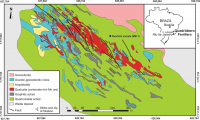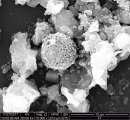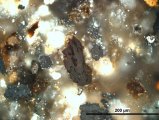News archive
News older than one year.
Research Reports 2017
Annual report on scientific activities of staff of the Institute of Geology – Research Reports 2017 – has been published.
Institute of Geology at Science Fair 2019
For the first time in its history, the Institute of Geology participated in the annual Science Fair held at the PVA EXPO Exhibition Center in Prague-Letňany in early June. This event presented over 100 displays from 54 institutes of the Czech Academy of Sciences and many other institutions and companies. According to the organizers, the fair was visited by approximately 30,000 during the 3 days. It was a pleasure to see that the stand of the Institute of Geology was highly attended. Its main attractions included an exposition of minerals and fossils, presentations on mercury research in tree trunks and information on the latest research on moldavites, sandstone weathering forms, accumulation of heavy metals in mushrooms. Photographs from discoveries of large caves were meeting a lot of interest. The greatest success, however, was microscopy of fossils together with a geo-quiz after the completion of which visitors could keep a mineral sample of their choice. The quiz was completed (either individually or in a group) by more than 250 visitors of all ages. For additional details on the Fair click here.
Mercury deposition in the Czech Republic decreasing in the 21st century
Mercury as a global pollutant is regularly mentioned in the news with respect to discussions about its emissions. Due to the low reactivity of gaseous elemental mercury in the atmosphere the wet deposition is low at 2–3 µg/m2/year. In forest environment, the main deposition path of Hg to the forest floor is litterfall. Litterfall Hg deposition, including deposition of biomass, such as needles, twigs, cones and bark, reaches usually 20–50 µg/m2/year. Long-term research of two mountain lake catchments in the Šumava (Bohemian Forest) National Park area indicated a significant decrease in Hg deposition in litterfall since the beginning of the 21st century. Furthermore, this research shows that the bark beetle infestation may increase Hg deposition up to 5 fold due to high biomass deposition. This study evaluated individual contribution of spruce litterfall components, such as needles, twigs, cones, bark, lichen and unidentifiable debris separately. Research published in Science of the Total Environment (IF 4,6) Journal was performed within a broad cooperation with the Biology Centre of the Czech Academy of Sciences, U.S. Geological Survey and Global Change Research Centre of the Czech Academy of Sciences.
15th International Ichnofabric Workshop in Prague
Radek Mikuláš convened the 15th International Ichnofabric Workshop to Prague (April 27 – May 5, 2019). Thirty-two specialists from over the world presented recent contributions from the mainstream branch of ichnology, e.g., ichnofabrics of terrestrial systems. A special discussion block was devoted to the use of computed tomography in the study of ichnofabric. Despite severe health complications of the convenor, the workshop was held at the scheduled time and followed the previously announced plan of excursions. In result, most of the sites known to a few people only through publications were now visited and evaluated directly by the top ichnologists. See Web page and Abstracts & Guidebook.
Some aspects of mercury records in tree rings
Tree-rings as a geochemical archive were presented as a topic studied within the Department of Environmental Geology and Geochemistry of the Institute of Geology CAS. The article describes some aspects of mercury records that can be deciphered from Larch and Pine tree rings as well as some peculiarities of the associated fieldwork. In Czech only.
Molybdenum isotopic signal survives in ancient, strongly metamorphosed rocks, a new study revealed
Molybdenum isotopic composition (98Mo/95Mo) provides important clues to paleoenvironmental changes of the Earthʼs oceans and atmosphere throughout the geological history. Previous studies were predominantly focused on black shales which reflected the degree of atmosphere oxygenation. Nevertheless, the new study published in the Scientific Reports journal (link here), also contributed by the Institute of Geology CAS, revealed that even ancient rocks (~2.1 Ga Mn ores from Brazil), which underwent high degrees of metamorphism (> 600 °C) retain Mo isotopic signal. Thus, these data argue for the presence of oxic–anoxic-stratified Palaeoproterozoic oceans. This is the first contribution since the new Mo isotopic methodology has been established in the joint laboratory of the Institute of Geology of the Czech Academy of Sciences and Czech Geological Survey.
Article on dust particles published in the ABC journal
Images of dust particles from a number of case studies performed at the Institute of Geology CAS were published in the popular ABC magazine as a part of the science-promotion project Strategie AV21, Natural Hazards. The article "InVisible Army – Dust everywhere you look" (in Czech) was aimed at the presentation of common dust particles around us to young readers from the viewpoint of electron microscopy.
Award for talented PhD student
Simona Krmíčková, a PhD student employed with the Department of Geological Processes, has been awarded the Brno PhD Talent scholarship. In her dissertation, Simona Krmíčková focuses on the Sr–Nd–Pb–Hf radiogenic isotope study of magmatic rocks from the broader surroundings of Brno. On 28th February 2019, she received a symbolic cheque for CZK 300,000 from the hands of Markéta Vaňková, the mayor of the statutory city of Brno.
Dust particles investigation in the Meteor programme of the Czech Radio broadcast
Tomáš Hrstka, who is involved in the development of innovative automated electron scanning microscopy at the Institute of Geology CAS was invited to the Czech Radio to talk about the study of dust particles in the famous "Meteor" popular science broadcast. This interview was conducted within the popular science project Strategie AV21, Natural Hazards. Meteor o teleportaci, kojícím pavoukovi, sexu a písních kosmických; time 31:41 (Tracing dust particles).
Cooperation with the European Space Agency
Dr. Tomáš Kohout, working for University of Helsinki and the Institute of Geology CAS is cooperating in the APEX nanosatellite project, which is a part of the Hera mission of the European Space Agency to be launched in 2023. Dr. Kohout is involved in the preparation of scientific observations and autonomous navigation. For additional info click here.











